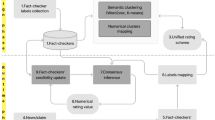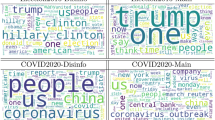Abstract
Fact checking is an important topic that needs to be studied scientifically to determine how fake news is spread. Previous work in this area has primarily focused on document- level fact checking. In this paper, however, we will focus on individual statements and the relationship between target statements and the overall news text. In larger context, we will compare statements to known facts, which we will tag within the statement. For dual verification, we will compare our findings to forty mainstream news sources as well as the online encyclopedia (Wikipedia). If a news is detected as fake the existing techniques should block it immediately due to its function, as we cannot replace it. However if a news is detected as fake, we need at least an expert opinion or review before blocking that particular news. This process helps third-party fact-checking organizations to solve the issue; but it is also a time-consuming process. We will attempt to solve the problem of automatically identifying factual claims at the sentence level. Despite its importance, this is a relatively under-studied problem. Existing fake news systems are based on predictive models that simply classify whether a news item is fake or not. Some models use source reliability and network structure so the major challenge in these cases is to train the model. But due to the unavailability of corpora, this is impossible to accomplish. We created a new corpus for social media claims, containing statements that have been fact checked by three reputable sources, and then trained a machine learning model to predict the facts of the news. We presented a fact checking system that takes news as input and then produces an output with an aggregation such as fake, non fake or unclear. To the best of our knowledge it is the only system that has such capabilities.
Access this chapter
Tax calculation will be finalised at checkout
Purchases are for personal use only
Similar content being viewed by others
References
Zannettou, S., Sirivianos, M., Blackburn, J., & Kourtellis, N. (2019). The web of false information: Rumors, fake news, hoaxes, clickbait, and various other shenanigans. Journal of Data and Information Quality, 11(3). https://doi.org/10.1145/3309699
Lazer, D. M. J., Baum, M. A., Benkler, Y., Berinsky, A. J., Greenhill, K. M., Menczer, F., & Zittrain, J. L. (2018). The science of fake news. Science, 359(6380), 1094–1096. https://doi.org/10.1126/science.aao2998
Chatzimilioudis, G., Konstantinidis, A., Laoudias, C., & Zeinalipour-Yazti, D. (2012). Crowdsourcing with smartphones. IEEE Internet Computing, 16(5), 36–44. https://doi.org/10.1109/MIC.2012.70
Howe, J. (2006). The rise of crowdsourcing. In Wired Magazine, 14, 1–4.
Zhou, Z., Guan, H., Bhat, M. M., & Hsu, J. (2019). Fake news detection via NLP is vulnerable to adversarial attacks. arXiv preprint arXiv:1901.09657.
Dumitrache, A., Inel, O., Aroyo, L., Timmermans, B., & Welty, C. (2018). CrowdTruth 2.0: quality metrics for crowdsourcing with disagreement. arXiv preprint arXiv:1808.06080.
Popat, K., Mukherjee, S., Strötgen, J, & Weikum, G. (2016). Credibility assessment of textual claims on the web. In Proceedings of the 25th ACM International on Conference on Information and Knowledge Management. ACM, 2173–2178.
Rashkin, H., Choi, E., Jang, J. Y., Volkova, S., & Choi, Y. (2017). Truth of varying shades: Analyzing language in fake news and political fact-checking. In EMNLP 2017 - Conference on Empirical Methods in Natural Language Processing, Proceedings, (pp. 2931–2937). https://doi.org/10.18653/v1/d17-1317
Nakashole, N., & Mitchell, T. M. (2014). Language-aware truth assessment of fact candidates. In 52nd Annual Meeting of the Association for Computational Linguistics, ACL 2014 - Proceedings of the Conference (Vol. 1, pp.1009–1019). https://doi.org/10.3115/v1/p14-1095
Weber, K., & Alcock, L. (2004). Semantic and syntactic proof productions. Educational studies in mathematics, 56(2–3), 209–234.
Ahmed, S., Hinkelmann, K., & Corradini, F. (2019). Combining machine learning with knowledge engineering to detect fake news in social networks-a survey. In Proceedings of the AAAI 2019 Spring Symposium (Vol. 12, p. 8).
Ahmed S., Balla K., Hinkelmann K., & Corradini F. (2021). Fact checking: Detection of check worthy statements through support vector machine and feed forward neural network. In: K. Arai (Ed.), Advances in information and communication. FICC 2021 (Vol. 1364) Advances in Intelligent Systems and Computing . Springer. https://doi.org/10.1007/978-3-030-73103-8_37.
Ahmed, S., Hinkelmann, K., & Corradini, F. (2020). Development of fake news model using machine learning through natural language processing. International Journal of Computer and Information Engineering, 14(12), 454–460.
Houvardas, J., & Stamatatos, E. (2006). N-gram feature selection for authorship identification. Lecture Notes in Computer Science (Including Subseries Lecture Notes in Artificial Intelligence and Lecture Notes in Bioinformatics), 4183 LNCS, 77–86. https://doi.org/10.1007/11861461_10.
Banko, M., Cafarella, M. J., Soderland, S., Broadhead, M., & Etzioni, O. (January, 2007). Open information extraction from the web. In IJCAI (Vol. 7, pp. 2670–2676).
Magdy, A., & Wanas, N. (2010). Web-based statistical fact checking of textual documents. In International Conference on Information and Knowledge Management, Proceedings pp. 103–109. https://doi.org/10.1145/1871985.1872002
Rubin, V. L., Chen, Y., & Conroy, N. J. (November, 2015). Deception detection for news: three types of fakes. In Proceedings of the 78th ASIS&T Annual Meeting: Information Science with Impact: Research in and for the Community (p. 83). American Society for Information Science.
Bajaj, S. (n.d.). The pope has a new baby! Fake news detection using deep learning. Retrieved from https://web.stanford.edu/class/cs224n/reports/2710385.pdf.
Zhou, X., Cao, J., Jin, Z., Xie, F., Su, Y., Chu, D., & Zhang, J. (2015, May). Real-Time News Cer tification System on Sina Weibo. In Proceedings of the 24th International Conference on World Wide Web (pp. 983–988). ACM.
Bengio, Y. et al. (2003) A neural probabilistic language model. Journal of Machine Learning Research. https://doi.org/10.1162/153244303322533223
Baly, R., Mohtarami, M., Glass, J., M`arquez, L., Moschitti, A., & Nakov, P. (2018b). Integrating stance detection and fact checking in a unified corpus. In Proceedings of the 16th Annualw Conference of the North American Chapter of the Association for Computational Linguistics. New Orleans, LA, USA: NAACL-HLT ’18.
Nakov, P., Mihaylova, T., Marquez, L, Shiroya, Y., & Koychev, I. (2017). Do not trust the trolls: Predicting credibility in community question answering forums. In Proceedings of the International Conference Recent Advances in Natural Language Processing (RANLP) (pp. 551–560).
Thorne, J., Vlachos, A., Christodoulopoulos, C., & Mittal, A. (2018). Fever: A large-scale dataset for fact extraction and verification. In Proceedings of the 2018 Conference of the North American Chapter of the Association for Computational Linguistics (HLT-NAACL) (pp. 809–819).
Wang, W. Y. (2017). Liar, liar pants on fire: A new benchmark dataset for fake news detection. In Proceedings of the 55th Annual Meeting of the Association for Computational Linguistics (Volume 2: Short Papers) (pp. 422–426). Association for Computational Linguistics.
Nguyen, A. T., Kharosekar, A., Lease, M., & Wallace, B. C. (2018). An interpretable joint graphical model for fact-checking from crowds. In 32nd AAAI Conference on Artificial Intelligence, AAAI 2018, ((3), pp. 1511–1518).
Potthast, M., Hagen, M., Gollub, T., Tippmann, M., Kiesel, J., Rosso, P., & Stein, B. (2013). Overview of the 5th international competition on plagiarism detection. CEUR Workshop Proceedings (Vol. 1179).
Mihaylova, T., Nakov, P., Màrquez, L., Barrón-Cedeño, A., Mohtarami, M., Karadzhov, G., & Glass, J. (2018). Fact checking in community forums. In 32nd AAAI Conference on Artificial Intelligence, AAAI 2018 (pp. 5309–5316).
Karadzhov, G., Nakov, P., Màrquez, L., Barrón-Cedeño, A., & Koychev, I. (2017a). Fully automated fact checking using external sources. In International Conference Recent Advances in Natural Language Processing, RANLP, 2017-Sept (February 2018) (pp. 344–353). https://doi.org/10.26615/978-954-452-049-6-046
Obrien, N., Latessa, S., Evangelopoulos, G., & Boix, X. (2018). The language of fake news: Opening the black-box of deep learning based detectors. In Proceedings of the Thirty-second Annual Conference on Neural Information Processing Systems (NeurIPS)–AI for Social Good.
Author information
Authors and Affiliations
Corresponding author
Editor information
Editors and Affiliations
Rights and permissions
Copyright information
© 2022 The Author(s), under exclusive license to Springer Nature Switzerland AG
About this chapter
Cite this chapter
Ahmed, S., Hinkelmann, K., Corradini, F. (2022). Fact Checking: An Automatic End to End Fact Checking System. In: Lahby, M., Pathan, AS.K., Maleh, Y., Yafooz, W.M.S. (eds) Combating Fake News with Computational Intelligence Techniques. Studies in Computational Intelligence, vol 1001. Springer, Cham. https://doi.org/10.1007/978-3-030-90087-8_17
Download citation
DOI: https://doi.org/10.1007/978-3-030-90087-8_17
Published:
Publisher Name: Springer, Cham
Print ISBN: 978-3-030-90086-1
Online ISBN: 978-3-030-90087-8
eBook Packages: Intelligent Technologies and RoboticsIntelligent Technologies and Robotics (R0)




